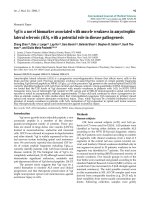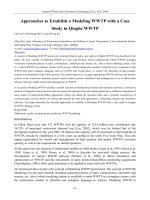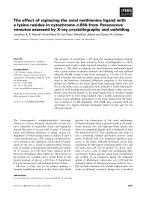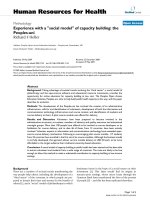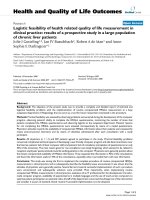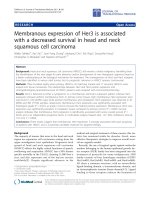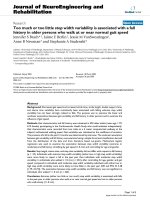half year report 1999 good half-year results with a further increase in net income the holderbank group confirms its strength and flexibility in the face of rapidly changing market conditions
Bạn đang xem bản rút gọn của tài liệu. Xem và tải ngay bản đầy đủ của tài liệu tại đây (881.81 KB, 35 trang )
1999
HALF-YEAR REPORT
Good half-year results: With a further in-
crease in net income the “Holderbank” Group
confirms its strength and flexibility in the
face of rapidly changing market conditions.
HOLDERBANK
70° 80°
E
100° 110° 120° 130° 140°
150° 160° 170°
S
190° 200° 210° 220° 230°
The Gladstone plant of Queensland Cement Ltd.
(Australia). The new kiln line offers various possi-
bilities for the use of alternative fuels.
“Holderbank” Group
First half 1999 1998 ±%
Sales of cement and clinker million t 35.3 31.7 +11.4
Sales of aggregates million t 40.0 38.0 +5.3
Sales of ready-mixed concrete million m
3
10.4 10.0 +4.0
Personnel number 40,932 39,651 +3.2
Net sales million CHF 5,660 5,366 +5.5
Operating profit million CHF 749 719 +4.2
Cash flow from operating activities million CHF 483 485
-
0.4
Group net income before
minority interests million CHF 391 372 +5.1
Group net income after
minority interests million CHF 311 290 +7.2
Earnings per dividend-bearing bearer share CHF 43.95 40.65 +8.1
Fully diluted earnings per bearer share CHF 43.50 40.20 +8.2
Fully diluted earnings per registered share CHF 8.70 8.04 +8.2
1
KEY FIGURES
Net sales per region first half
Europe 42%
Latin America 23%
North America 20%
Africa Middle East 8%
Asia Pacific 7%
The half-year result was again very favorable and under-
scored the strength of the Group in the face of rapidly
changing market conditions. Once more the three major
“Holderbank” regions Europe, North America and Latin
America were key contributors to the Group’s overall suc-
cess. The two other regions Africa Middle East and Asia
Pacific also succeeded in boosting both sales volume and
revenue. Juan Minetti, the number two in the Argentine
cement market, was consolidated for the first time during
the period under review. The decision to boost our pres-
ence in Asia last year proved to be strategically sound.
The companies in that region are again in good financial
shape and prepared for the next economic upswing.
2
CHAIRMAN’S LETTER
Dear shareholders and employees,
Ladies and gentlemen,
Very Good Half-Year Results
“Holderbank” posted further growth in
the first half of 1999. The unbroken
earning power of the Group stems from
a satisfying level of demand in many
markets and is also a sign of our intrin-
sic strength that comes with greater ef-
ficiency – particularly in production – as
well as further concentration on our
core business. Compared with the first
six months of 1998, our Group compa-
nies in Europe, North America, Africa
and the Middle East made a stronger
contribution to operating profit. Owing
to higher depreciation in connection
with the commissioning of the new ce-
ment plant in Vietnam and a new kiln
line in the Philippines, the operating
profit of the Group region Asia Pacific
remained at the same level as 1998. A
slight decline in operating profit was
recorded, however, for Latin America.
Argentine-based Juan Minetti, resulting
from the merger with “Holderbank”
Group company Corcemar, was consoli-
dated for the first time. This new com-
pany has rapidly become integrated
into the Group network and is in the
process of accessing available synergy
potential. Overall the operating profit
of the Group increased by 4 percent to
CHF 749 million and Group net income
after minority interests rose by 7 per-
cent to CHF 311 million. Cash flow from
operating activities was maintained at
an equivalent level to the previous first
half-year. However, if currency factors
and changes in the scope of consolida-
tion are excluded, cash flow from oper-
ating activities increased by 13 percent.
Improved Economic Environment
in Europe
Reflecting a flow of public-sector credit
into infrastructure expansion and some
growth in private construction in vari-
ous locations, demand for building ma-
terials increased in all of “Holderbank’s”
major European markets. This is espe-
cially positive due to the hard winter in
the Alpine region hampering the start
of the season. Cement consumption is
likely to rise further in the second half of
the year and is expected to produce a
sustained improvement in results.
Strong Business Activity
in North America
Cement sales in the United States
once again exceeded the already high
figure for 1998, causing the cement in-
3
4
dustry to increase imports. During the
past six months, Canada’s economy
also picked up substantially. This, to-
gether with further gains in productiv-
ity, resulted in Group company St.
Lawrence Cement achieving a marked
performance improvement. At both
Group companies, new plants are in
the planning or construction phase to
reduce capacity bottlenecks and opti-
mize distribution cost structures. Fa-
vorable business development will
also be clearly reflected in the full year
figures for both firms.
Latin America Remains a Strong
Group Region
From the Group standpoint, the con-
struction business in Mexico and Costa
Rica developed very satisfactorily.
Group companies Apasco and Grupo
Incsa-PC significantly improved their
financial results. In South America, the
effects of the Asian crisis, together
with prevailing political uncertainties,
impacted negatively on demand.
Brazil, following a massive currency de-
valuation, saw only a modest contrac-
tion in construction volume, but lower
prices led to temporarily weaker re-
sults at “Holdercim” Brasil. The first-
time consolidation of Juan Minetti in
Argentina made a positive contribu-
tion. General business conditions are
expected to remain stable in the sec-
ond half of 1999.
Group Region Africa Middle East
Stronger
Although signs of stagnation could not
be ignored, our Group companies
maintained their respective market
positions well. Practically all of them
contributed to the growth in “Holder-
bank’s” business. The gains in effi-
ciency achieved in Morocco and
Lebanon and the encouraging perfor-
mance at our grinding stations and
import terminal in West Africa are
worthy of special mention. It is likely
that demand in South Africa will im-
prove somewhat in the second half of
1999 and that building activity in other
markets will remain at a reasonable
level.
South East Asia on the Threshold
of Recovery
The economic downturn witnessed in
Asia should cease this year, and an ini-
tial recovery appears to be in the off-
ing. In the construction sector, demand
weakened further in the first half of the
5
year, but the decline was within a far
narrower range than in 1998. Business
growth continued in China and the Pa-
cific region. Over the past few months,
our new and important holdings in
Thailand and the Philippines have
been restructured and the refinancing
process is progressing well, providing
the opportunity to draw above-average
benefit from the next business cycle.
However, South East Asia is unlikely to
witness sustained economic growth
before the year 2000. Meanwhile, fur-
ther business acceleration is antici-
pated in Australia and New Zealand
during the second half of 1999.
Events Subsequent to June 30, 1999
Within the scope of optimizing plant lo-
cation, Alsons Cement in the Philip-
pines sold its Kiwalan factory at the
beginning of the second half. The pro-
ceeds will enable the company to repay
debt. Within the framework of focusing
on core business, “Holderbank” con-
tinued its disposal of stakes in con-
crete chemical businesses, this time in
Mexico and Colombia.
1998 Performance to Be Surpassed
Provided that there is no fundamental
deterioration in general economic con-
ditions in the second half of 1999 and
the Swiss franc remains at its present
level, we expect to see further growth
in Group net income over the entire
business year.
Dr. h.c. Thomas Schmidheiny
Chairman and Managing Director
6
BUSINESS REVIEW
Europe
Europe’s economy developed surpris-
ingly well in the first half of 1999. De-
mand for building materials in virtually
all of “Holderbank’s” major markets
showed strong growth. This can be
largely attributed to an increase in gov-
ernment spending, with large sums re-
leased to finance infrastructure expan-
sion. Some residential building pro-
jects and construction work on new
production and distribution facilities
provided further impetus.
Belgium, France and Spain rank among
those western European nations show-
ing above-average growth in the con-
struction sector. Reporting a 10 per-
cent growth rate, Spain once again led
the field. Western Germany experi-
enced an end to the building recession,
while eastern Germany saw no clear
turnaround. Major projects such as
“Rail 2000” and the new trans-Alpine
railway route (NEAT) helped to stimu-
late the Swiss construction industry.
However, heavy snowfalls at the begin-
ning of the year caused lengthy work
interruptions. Italy’s building sector
showed no recovery, with overcapacity
continuing to plague the industry. Mar-
kets in central and southern Europe
tended to stagnate. A lack of willing-
ness in the Czech Republic to introduce
further reforms even exacerbated the
recession there. The economic devel-
opment in Hungary was better. Busi-
ness in markets along the Danube was
temporarily dampened, however, by
the blockage of the waterway due to
the war in Kosovo.
Several changes in the scope of con-
solidation occurred compared with
the first half of 1998. In the cement
segment, the companies in Romania
and Bulgaria were fully consolidated.
To maintain market flexibility and in
the interests of focusing business ac-
tivities on strategically important core
products, Holderchem Euco in Switzer-
land, C.I.A. in France and Holderchem
Euco in Spain were sold. Smaller ac-
quisitions and disposals were made
in the aggregates and concrete sec-
tors.
Major financial transactions included
the successful buyout of minority
shareholders at HISALBA in Spain and
southern Germany’s Breisgauer Ce-
ment and the merger of Société Suisse
de Ciment Portland with “Holderbank”
Financière Glaris.
7
Growth in cement and clinker deliver-
ies resulted in a further improvement
in plant capacity utilization rates.
HISALBA (+8 percent) and German-
based Alsen (+14 percent) achieved
impressive sales figures. Alsen bene-
fited in particular from a surge in
building activity related to the stag-
ing of Expo 2000 in Hanover. Larger
sales volumes were also recorded by
our subsidiaries in Belgium and
France. In contrast, Group companies
in the Czech Republic, Slovakia and
Croatia suffered market-induced set-
backs.
A number of Group companies re-
ported massive gains in deliveries of
aggregates in the first half of 1999.
HISALBA scored a remarkable increase
of 25 percent or 1 million tonnes.
Belgian-French group Obourg/Origny,
which has been operating under joint
management since last autumn, per-
formed very successfully, also boost-
ing sales of gravel and sand by 1 mil-
lion tonnes. Sales in Germany, Switzer-
land and Greece showed strong
growth. In Hungary, expired quarrying
permits and the new strategic posi-
tioning of the aggregates business led
to a contraction in volume. With one
Cement and clinker 97 98 99
99: 10.974 million t +3.5%
98: 10.604 million t
97: 10.107 million t
Ready-mixed concrete 97 98 99
99: 5.342 million m
3
+6.2%
98: 5.031 million m
3
97: 4.685 million m
3
Aggregates 97 98 99
99: 21.266 million t +10.7%
98: 19.213 million t
97: 18.647 million t
Consolidated sales volumes first half
8
exception, all Group companies oper-
ating in the concrete sector achieved
volume gains.
Increased demand and slightly im-
proved consolidated net sales of CHF
2,405 million (first half 1998: 2,322)
boosted operating profit to CHF 239
million (first half 1998: 215). It should
be remembered, however, that the
harsh winter in several countries re-
sulted in a poor start to the season,
very much in contrast to the early part
of the previous year. Group companies
affected by this situation were unable
to offset the resultant declines in sales
by midyear. HISALBA again presented
an outstanding performance, while
Obourg/Origny, Alsen and HCB also
recorded considerably higher operat-
ing profits. The better midyear results
posted by Group companies in the
Czech Republic and Slovakia reflect the
success of their current efficiency en-
hancement programs. Finally, special
mention must be made of the satisfying
results reported by Madrid-based
UMAR, our international cement and
raw materials trading organization.
Against a backdrop of turmoil in Asia
and excess volumes in the ASEAN na-
tions, UMAR performed an important
turntable function by absorbing free
tonnages for supply to US Group com-
pany Holnam.
There are various signs indicating that
the overall economic picture in Europe
will become progressively brighter in
the months ahead and that construc-
tion activity – and especially cement
consumption – will tend to increase.
We are also optimistic about develop-
ments in the year 2000. We expect that
the single European market will con-
tinue to develop and that export-ori-
ented industries will again invest more
heavily in plant expansion. In our view,
a sustained improvement in earnings is
within reach.
North America
North America can again look back on
six months of stable growth. In the
United States, public and private de-
mand for building materials surpassed
last year’s high figure. However, poor
weather conditions and labour short-
ages led to prolonged delays at many
construction sites, resulting in cement
consumption which did not quite
match expectations. In Canada, the
economic picture continued to im-
prove, impacting positively on the
9
building industry. In addition, the
disparity in demand between the
Provinces of Ontario and Quebec nar-
rowed considerably.
US subsidiary Holnam boosted its
cement deliveries by just under 10
percent to approximately 6.5 million
tonnes, despite having disposed of the
Seattle cement facility. The company
was stretched to the limit to supply the
required amounts and cement grades
to customers within its sales territory.
Operating at full capacity, Holnam was
forced to rely on more imports, which
in turn increased logistics and trans-
port costs for deliveries to individual
construction sites. St. Lawrence Ce-
ment achieved a solid rise of more than
15 percent in cement deliveries in
Canada and in adjoining northeast US
markets.
In connection with the decision to with-
draw from the market on the northern
Pacific coast, Holnam divested itself of
its raw material reserves on Texada Is-
land and thereby moved out of the ag-
gregates business. In the first half of
1999, St. Lawrence Cement marketed
approximately 4.5 million tonnes of
gravel and sand, thus scoring a gain of
Cement and clinker 97 98 99
99: 8.102 million t +10.5%
98: 7.333 million t
97: 6.504 million t
Ready-mixed concrete 97 98 99
99: 0.824 million m
3
+17.5%
98: 0.701 million m
3
97: 0.669 million m
3
Aggregates 97 98 99
99: 4.496 million t
–
19.8%
98: 5.603 million t
97: 5.460 million t
Consolidated sales volumes first half
7 percent. The Canadian ready-mixed
concrete plants even raised output by a
very respectable 18 percent.
10
Group region North America also
posted very good financial results.
Consolidated net sales rose by 7 per-
cent to CHF 1,186 million due to both
volume and price increases. The com-
parably smaller gain in operating profit
of 3 percent to CHF 169 million can be
largely attributed to higher distribution
expenses and an increase in imports
at Holnam. St. Lawrence Cement, by
contrast, improved its operating profit
by almost 30 percent.
In response to continuing excess de-
mand, these Group companies are
developing major expansion plans.
Considerable progress has already
been made at St. Lawrence for two
slag grinding plants in the United
States and Canada respectively and
the construction of a large cement
plant in New York State. Holnam is
also making considerable headway on
various projects. The doubling of ca-
pacity at the Midlothian plant in Texas
is progressing on schedule, and the
first sod has been turned for a new ce-
ment facility with an annual capacity
of 1.9 million tonnes in the State of
Colorado. Plant expansion work is also
underway at the GranCem® location in
Chicago.
There is no doubt that building activity
in the United States will remain at a
high level in the second half of 1999.
Even if interest rate increases in subse-
quent years slow the economy, our pro-
duction capacity will continue to be
fully utilized. In Canada, the outlook
for the current year is very positive.
Further gains in productivity will also
be clearly reflected in the end-1999
results.
Latin America
The Latin American markets served
by “Holderbank” presented a mixed
picture in terms of performance in the
first half of 1999. Mexico became more
strongly integrated in North America’s
NAFTA, which boosted growth. At
the same time greater stability was
achieved. Having shaken off the turbu-
lence dogging the international finan-
cial markets, Central America and parts
of the Caribbean reported positive
macroeconomic trends. South America,
meanwhile, felt the effects of the Asian
crisis. Furthermore, a certain degree of
uncertainty remains about the out-
come of elections and changes in gov-
ernment in three of the countries in
which the Group operates. By amend-
ing its constitution, Venezuela’s new
government aims to initiate a radical
program of reforms. The divergence be-
tween inflation and the external value
of the nation’s currency remained an
unsolved problem in the first half of the
year. In Colombia, negotiations with
guerrilla leaders did not produce the
hoped-for breakthrough. This Andean
nation suffered from a continuing high
fiscal deficit and general pressure on
its currency. A high budget deficit
and greatly weakened banking system
caused a strong dampening of the
economy and a massive currency
devaluation in Ecuador. As a result,
coastal infrastructure destroyed by
“El Niño” in 1998 could not be repaired
to the desired extent. Despite the 40
percent devaluation of its currency,
Brazil was spared spiraling inflation
thanks to an astute monetary policy.
The International Monetary Fund’s
broad support for the government’s
efforts prompted only a slight decline
in gross domestic product and a corre-
sponding decrease in construction ac-
tivity. Argentina’s economy weakened
considerably because of the contrac-
tion in exports to Brazil and high real
interest rates. However, in the lead-up
to the elections, the building industry
profited from public-sector projects.
11
Low raw material prices and persistent
high interest rates in Chile triggered a
recession. By easing interest rates
towards the end of the second quarter
of 1999, the government reacted cor-
rectly but, unfortunately, too late.
Capitalizing on a robust construction
market, Apasco in Mexico lifted domes-
tic cement deliveries by about 3 per-
cent. However, compared with the first
half of 1998, exports were about 50
percent lower. Grupo Incsa-PC in Costa
Rica turned in a very favorable perfor-
mance, with cement sales up by an im-
pressive 13 percent. Cementos Caribe
in Venezuela succeeded in almost en-
tirely offsetting the 15 percent decline
in domestic sales with a further in-
crease in cement and clinker exports.
By contrast, La Cemento Nacional in
Ecuador and Cementos Boyacá in
Colombia experienced strong cyclically
induced declines in shipments. In
Brazil, the contraction in cement con-
sumption in “Holdercim” Brasil’s mar-
ket remained within narrow limits, pro-
ducing a drop in sales of only 1 percent.
Consolidated since the second half of
1998, Corcemar in Argentina merged
retroactively at the beginning of 1999
with Juan Minetti. The new group sold
12
just under 1.5 million tonnes of cement
in the first six months of this year and
firmly established itself as Argentina’s
number two in the building materials
market. Meanwhile, Chile’s market vir-
tually slumped with Cemento Polpaico
cement deliveries plummeting by 28
percent.
The 10 percent growth in consolidated
cement and clinker deliveries largely
reflects the changes in the scope of
consolidation. Whereas sales of ready-
mixed concrete remained largely the
same due to gains in Mexico and
Venezuela, deliveries of aggregates de-
clined across the board.
In terms of financial results, Group re-
gion Latin America maintained its pre-
mier position within the Group during
the first half of 1999 despite setbacks
caused by adverse market conditions.
With consolidated net sales revenue
at CHF 1,352 million (first half 1998:
1,325), operating profit was a solid CHF
254 million (first half 1998: 272). This
favorable half-year performance is the
result of several factors, the most im-
portant being continued further growth
at Apasco, which profited from higher
volumes and prices at home as well as
stable costs. Now operating at full ca-
pacity, the grinding facilities for the al-
Cement and clinker 97 98 99
99: 9.429 million t +9.9%
98: 8.577 million t
97: 8.338 million t
Ready-mixed concrete 97 98 99
99: 3.006 million m
3
–
2.8%
98: 3.094 million m
3
97: 2.539 million m
3
Aggregates 97 98 99
99: 5.386 million t
–
14.1%
98: 6.269 million t
97: 4.957 million t
Consolidated sales volumes first half
13
vidual economies unlikely to witness a
recovery before the year 2000 – Latin
America will make a solid contribution
to Group profit in 1999. This forecast is
based on the generally advantageous
market position of Group companies in
the region, low-cost production com-
bined with attractive prices, and the
first-time inclusion of Juan Minetti’s
results.
Africa Middle East
As expected, business development in
the markets we serve in Africa and the
Middle East tended to be rather un-
eventful.
In Morocco, the economy slowed some-
what, causing visible signs of stagna-
tion in the construction sector. West
Africa – i.e. Côte d’Ivoire, Burkina Faso
and Guinea – saw a further rise in con-
struction volume. Although the newly
elected government in South Africa has
set stability and continuity as its pri-
mary goals, demand was generally
weak in the first half of 1999 due to the
continuing lack of large-scale state-
backed infrastructure projects. In con-
trast, building markets in Madagascar
and La Réunion experienced an up-
swing. Capacity utilization rates in
ternative fuel, petcoke, at the Orizaba
and Tecomán plants contributed signif-
icantly to an increase in efficiency. In
Brazil and Chile, where currency depre-
ciation prompted a sharp drop in the
price of cement, any recovery is un-
likely to commence before the second
half of 1999.
The most significant event on the in-
vestment front was the merger be-
tween Corcemar and Juan Minetti in Ar-
gentina as at January 1, 1999. In the
meantime, this new Group company
has introduced a number of cost reduc-
tion and reorganization measures
which are successively producing sub-
stantial synergies. The grinding plant
under construction in Campana near
Buenos Aires is progressing rapidly
and will considerably strengthen our
position in the capital from next
year. Also worthy of special mention is
the commissioning of two grinding
plants in Nicaragua and the Dominican
Republic and the sale of the Brazilian
concrete chemicals unit.
“Holderbank” is confident about its
Latin American operations for the cur-
rent year. Despite largely adverse
macroeconomic conditions – with indi-
14
Egypt’s construction industry remained
high. “Holderbank” is represented in
the Egyptian market by a minority hold-
ing in Egyptian Cement. Owing to the
prevailing political uncertainties in
Lebanon, no turnaround was experi-
enced there. The only large-scale build-
ing projects underway are in Beirut. In
rural areas and smaller cities the pace
of new residential construction is cur-
rently quite modest.
The Macoma and Macoré groups,
which operate production and distribu-
tion facilities in Madagascar and La
Réunion respectively, turned in a very
successful performance in 1999. The
recommissioning of an import terminal
in Guinea also led to an increase in ce-
ment capacity. The upturn in cement
deliveries reflects the first-time inclu-
sion of Macoma’s and Macoré’s ton-
nages in the figures for this Group re-
gion and year-on-year sales growth of
9 percent for the West Africa group.
Cement shipments by Group compa-
nies in other markets almost matched
those in the first six months of 1998.
Aggregates underwent marked growth
of just under 30 percent. This positive
result can be attributed to an increase
in output of some 1 million tonnes
at our stone quarry operations in
Lebanon. Meanwhile, in South Africa,
deliveries dropped by about 20 percent
amid weaker demand. The modest
growth in consolidated ready-mixed
concrete sales is credited solely to
CIOR in Morocco.
Cement and clinker 97 98 99
99: 3.574 million t +7.6%
98: 3.321 million t
97: 3.589 million t
Ready-mixed concrete 97 98 99
99: 0.840 million m
3
+2.7%
98: 0.818 million m
3
97: 0.741 million m
3
Aggregates 97 98 99
99: 6.856 million t +28.9%
98: 5.318 million t
97: 4.455 million t
Consolidated sales volumes first half
15
The Pacific area remained largely un-
scathed by the negative course of
events in the ASEAN nations. New
Zealand posted extremely positive eco-
nomic results in the first half of 1999.
In Australia, business was quite re-
strained, however. The economy in Sri
Lanka has recently shown signs of
dampening somewhat. The cement in-
dustry also experienced stronger pres-
sure from imports. Although the pes-
simistic mood in Thailand is not quite
as pervasive as before, demand contin-
ued to weaken in the first half of 1999.
There is currently a lack of substan-
tial, government-financed infrastruc-
ture projects and private investment
also continues to move at a very cau-
tious pace. Quite stable conditions pre-
vailed in Malaysia, however, with con-
struction volumes holding up satisfac-
torily. Vietnam’s economy has lost
some of its momentum, as foreign di-
rect investment slipped to a very mod-
est level. Nevertheless, the govern-
ment is going ahead with a program to
improve the country’s infrastructure.
China continued to develop well. The
economy is still on an expansion path,
and the strong pace of construction
shows no sign of slackening. Due
mainly to a comparatively intact bank-
The consolidated turnover of this
Group region expanded by 8 percent to
CHF 473 million, with all Group compa-
nies – apart from Alpha Limited in
South Africa – contributing. Operating
profit rose by nearly 80 percent to CHF
43 million, a gain which can be attrib-
uted mainly to higher productivity in
Lebanon and Morocco and a solid per-
formance in West Africa.
The results of our companies in this
Group region are not expected to show
much change in the second half of
1999. On the other hand, Alpha Limited
– the largest company in the region – is
likely to close the year with an im-
proved performance over 1998.
Asia Pacific
In most of the Asian countries hit
hard by the crisis, the economic down-
turn appears to have bottomed out.
In various markets, the contraction in
demand has ceased – particularly in
the export-oriented industries. There
are even some signs of a very modest
recovery commencing. However, it will
require a strong commitment by all
political powers to restore the confi-
dence of domestic and foreign in-
vestors.
16
ing system, the Philippines ranks
among those nations on the brink of an
economic recovery.
All Group companies contributed to the
positive sales results. The impressive
increase of 75 percent in cement and
clinker sales can be credited to Alsons
Cement’s new kiln line in the Philip-
pines and Morning Star Cement’s Hon
Chong plant in Vietnam. A further con-
tributory factor was the first-time con-
solidation of Ruhunu Cement in Sri Lan-
ka and Tenggara Cement in Malaysia.
Our only companies in the aggregates
sector are located in the Philippines,
Australia and New Zealand. Queens-
land Cement and Milburn New Zealand
reported solid sales increases of 12
percent and 24 percent respectively.
Alsons Cement more than doubled its
aggregates deliveries. Our ready-
mixed concrete plants in Australia and
New Zealand also recorded higher
sales volumes.
Net sales in Group region Asia Pacific
amounted to CHF 393 million (first half
1998: 314) and at CHF 44 million oper-
ating profit matched the previous
year’s figure. The increase in sales
achieved by Milburn New Zealand,
Queensland Cement and Ciments de
Numbo in New Caledonia, together
with further headway made in rational-
izing operations, had an extremely pos-
itive influence on the financial results.
Solid contributions to operating profit
were also made by Puttalam Cement in
Sri Lanka, Morning Star Cement and
Tenggara Cement, whereas Alsons Ce-
ment in the Philippines suffered a loss
due to market factors.
Cement and clinker 97 98 99
99: 3.236 million t +75.1%
98: 1.848 million t
97: 2.457 million t
Ready-mixed concrete 97 98 99
99: 0.422 million m
3
+8.8%
98: 0.388 million m
3
97: 0.358 million m
3
Aggregates 97 98 99
99: 1.996 million t +23.5%
98: 1.616 million t
97: 1.477 million t
Consolidated sales volumes first half
17
continuing financial restructuring pro-
gram. Since both Group companies,
Alsons Cement and Union Cement,
have production facilities on the island
of Mindanao, “Holderbank” decided
shortly after the end of the first half-
year to sell the Kiwalan plant. The pro-
ceeds were used by Alsons Cement to
repay debt.
At the beginning of 1999, “Holderbank”
purchased 23 percent of Huaxin Cement,
whose shares are listed on the Shanghai
stock exchange. This company operates
a cement plant in central China. The com-
missioning of a new kiln line early in the
year has raised annual capacity at the
Huangshi plant to 3.5 million tonnes.
No sustained improvements in either
construction activity or cement de-
mand are expected in the ASEAN na-
tions in 1999. There are some indica-
tions, however, that the economic situ-
ation will brighten in the year 2000.
Given that business is likely to con-
tinue to expand in New Zealand, Mil-
burn’s performance will clearly surpass
last year’s level. The economic recovery
taking hold in Australia confirms
Queensland Cement’s optimism about
the 1999 business year.
The increase in investment activity by
“Holderbank” in the second half of 1998
was only partially reflected in the con-
solidated results, as our entry into Thai-
land and the strengthening of our market
positions in the Philippines and China
were achieved via minority holdings.
In Thailand, “Holderbank” succeeded in
raising its holding in Siam City Cement
to 28 percent through a share capital
increase towards the middle of 1999.
In line with “Holderbank” Group policy,
this company’s business focus is on the
core sectors of cement and concrete.
Several holdings engaged in non-core
operations were either sold or their busi-
ness activities terminated. Strong gains
were made in cement and clinker exports
during the period, and are expected to
reach a record level of about 5 million
tonnes in 1999. Thanks to this export
drive, the company was able to recom-
mission the last of the temporarily
closed kiln lines at the Saraburi plant.
A second focus of investment in the
second half of 1998 was on the Philip-
pines, where we acquired a 40 percent
holding in market leader Union Ce-
ment. In the first six months of 1999,
efforts at Union Cement centered on a
18
HALF-YEAR RESULTS
Consolidated statement of income “Holderbank” first half
Million CHF 1999 1998 ±%
Net sales 5,660 5,366 +5.5
Cost of products and services sold (3,419)(3,295)
Gross profit 2,241 2,071 +8.2
Distribution and selling expenses (946)(874)
Administrative expenses (428)(392)
Other depreciation and amortization (118)(86)
Operating profit 749 719 +4.2
Additional ordinary income 105 56
Financial expenses (272)(220)
Group net income before taxes 582 555 +4.9
Income taxes (191)(183)
Group net income before minority interests 391 372 +5.1
Minority interests (80)(82)
Group net income after minority interests 311 290 +7.2
CHF
Earnings per dividend-bearing bearer share 43.95 40.65
Fully diluted earnings per bearer share 43.50 40.20
19
Consolidated balance sheet “Holderbank”
Million CHF 30.06.99 31.12.98
Cash and cash equivalents 1,406 854
Accounts receivable 2,472 1,868
Inventories 1,398 1,238
Prepaid expenses and other current assets 257 180
Total current assets 5,533 4,140
Financial investments 1,976 1,926
Property, plant and equipment 11,424 10,111
Intangible and other assets 2,606 2,198
Total long-term assets 16,006 14,235
Total assets 21,539 18,375
Trade accounts payable 948 829
Current financing liabilities 2,384 1,598
Other current liabilities 1,193 910
Total short-term liabilities 4,525 3,337
Long-term financing liabilities 6,961 6,325
Long-term provisions 1,930 1,777
Total long-term liabilities 8,891 8,102
Total liabilities 13,416 11,439
Interests of minority shareholders 1,813 1,508
Authorized capital 377 363
Reserves 5,933 5,065
Total shareholders’ equity 6,310 5,428
Total liabilities and shareholders’ equity 21,539 18,375
20
Statement of changes in consolidated equity “Holderbank”
Million CHF 30.06.99 31.12.98
Authorized capital 363 362
Capital paid-in 14 1
Authorized capital 377 363
Uncalled capital 0 (5)
Capital paid-in 05
Uncalled capital 00
Reserves
Capital surplus 1,559 1,436
Capital paid-in 365 80
Shareholders’ equity of 1% convertible bond 043
Capital surplus 1,924 1,559
Retained earnings 3,583 3,261
Profit distribution (142)(141)
Group net income after minority interests 311 682
Change in reserve for treasury shares (30)(151)
Effect of change in participation (14)(68)
Retained earnings 3,708 3,583
Reserve for treasury shares 225 74
Change in treasury shares 30 151
Reserve for treasury shares 255 225
Cumulative currency translation adjustments (302)(41)
Currency translation adjustments 348 (261)
Cumulative currency translation adjustments 46 (302)
Total reserves 5,933 5,065
Total shareholders’ equity 6,310 5,428
21
Consolidated cash flow statement “Holderbank” first half
Million CHF 1999 1998 ±%
Operating profit 749 719 +4.2
Depreciation and amortization of operating assets 571 502
Other non-cash items 15 35
Change in net current assets (451)(488)
Cash generated from operations 884 768 +15.1
Additional ordinary income 83 46
Interest paid (279)(205)
Income taxes paid (205)(124)
Cash flow from operating activities A 483 485
–
0.4
Investments in property, plant and equipment net (466)(432)
Financial investments net (497)(285)
Cash flow from investing activities B (963)(717)+34.3
Dividends paid (158)(148)
Other financing activities 1,149 404
Cash flow from financing activities C 991 256 +287.1
Increase in cash and cash equivalents (A + B + C) 511 24
Cash and cash equivalents as at January 1 854 803
Increase in cash and cash equivalents 511 24
Effects of exchange rate movements 41 6
Cash and cash equivalents as at June 30 1,406 833
22
FINANCIAL REPORT
General
The consolidated 1999 half-year report
has been prepared in accordance with
International Accounting Standards
(IAS). The principles of preparing finan-
cial accounts are described in detail
in the 1998 annual report. The figures
contained in this interim statement are
not audited.
Changes in the Scope of
Consolidation
The current reporting period has seen
various changes occur in the scope of
consolidation. Juan Minetti (Argentina)
has been the most influential invest-
ment in terms of Group results. Addi-
tional new investments in Beloizvorski
Cement (Bulgaria), Cimentul (Roma-
nia), Tenggara Cement (Malaysia) and
Philippine-based Alsons Cement (pro-
portionate to full consolidation) have
also impacted Group results. Divest-
ments included Stamm Holding and
Holderchem Euco in Switzerland. In
addition, Group company HISALBA
(Spain) sold its Holderchem Euco con-
crete chemical business, Holnam (USA)
sold its Seattle plant, including raw
material reserves, and Alpha Limited
(South Africa) hived off Alpha Sacks.
Within the framework of concentrating
on core activities, the Group also sold
its shareholding in Euclid Chemical to
the former partners.
Foreign Currencies
The CHF has become slightly stronger
against the major “Holderbank” cur-
rencies, when considering the average
exchange rates (statement of income).
However, when considering the closing
exchange rates (balance sheet), the
CHF devalued sharply, with the excep-
tion of the main European currencies.
23
Average exchange rate in CHF (statement of income)
First half 1999 1998 ±%
1 EUR 1.60 1.62
–
1.2
100 BEF 3.96 3.99
–
0.8
100 FRF 24.36 24.52
–
0.7
100 ESP 0.96 0.97
–
1.0
100 DEM 81.69 82.26
–
0.7
1 USD 1.47 1.49
–
1.3
1 CAD 0.99 1.03
–
3.9
100 MAD 15.13 15.19
–
0.4
1 ZAR 0.24 0.29
–
17.2
1 AUD 0.95 0.96
–
1.0
1 NZD 0.79 0.82
–
3.7
Closing exchange rate in CHF (balance sheet) 30.06.99 31.12.98 ±%
1 EUR 1.60 1.61
–
0.6
100 BEF 3.96 3.99
–
0.8
100 FRF 24.38 24.52
–
0.6
100 ESP 0.96 0.97
–
1.0
100 DEM 81.77 82.23
–
0.6
1 USD 1.55 1.38 +12.3
1 CAD 1.05 0.89 +18.0
100 MAD 15.46 14.82 +4.3
1 ZAR 0.26 0.24 +8.3
1 AUD 1.02 0.84 +21.4
1 NZD 0.82 0.73 +12.3
